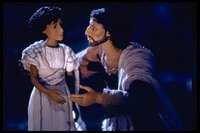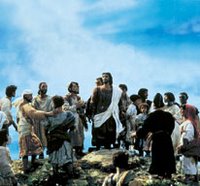
This is the the second of two posts about Ishmael in film.
The first, it turns out, was rather error strewn, and anyone with any decency would have gone and made the corrections and added the labels and so on before writing the second. He or she would probably also write a better more meaningful post for part two and reply to comments more consistently. But unfortunately, you got me.
There are 6 films that I'm able to lay my hands on that depict Ishmael, but to be honest none of them really do much of great interest with him. This is, I suppose, mainly because he is a minor character. The Bible, and the films that do adapt his story, or rather his part in Abraham's story, are not really interested in him, they are interested in Abraham and Sarah and how they act and react. There's a certain amount of etiology in the Bible's account: Ishmael goes on to be the father of the Ishmaelites (popularly considered to be the descendants of the Arab people), and some of the Edomites (Gen 36) who both become enemies of the Israelites at times (although trusted servants at others - 1 Chron 27:30 for example). Gen 25:18 makes special mention of the Ishmaelites living in "hostility" to all the other tribes.
Essentially though Ishmael is a passive character, acted upon by Abraham, Sarah, and to a lesser extent Hagar, but never really an active initiator. The last mention of Ishmael the man is from Genesis 25. He is with Isaac when Abraham is buried (which raises the question as to how contact was made / maintained between the half-brothers) and dies himself at the age of 137.
This doesn't leave scriptwriters a great deal to work with, and although with some characters such a blank sheet might be seen as an invitation to be creative, the need to focus on Abraham means that none of the films really take it.
The Bible (1966)
Sarai takes the initiative here, calling Hagar over and whispering into her ear. She waits for Abram, explains to him her plan. The enmity between Sarai and Ishmael (Gen 16:4) is made explicit early on with Hagar disdainfully comparing Sarai to "dried-up fruits", but it doesn't go to the extent we find in the rest of Genesis as Hagar does not flee from Sarah. The scene then changes to Abram's rescue of Lot (Gen 14), before returning to Ishmael's birth and childhood. But it's Sarah who urges Abraham to send them away, after Ishmael seizes a doll at a celebration of Isaac weaning, and then smashes it and buries it. Sarah again urges Abraham to take action; he is reluctant, but ultimately yields. The narrator adds that God also endorsed the plan in a sentence that sounds too ludicrously anachronistic to be from the KJV but actually is ("Let it not be grievous in thy sight because of the lad"). The next scene is of bright desert sands reflecting the sun and the suddenness of the switch from the previous night-time scene, to the brightness of this scene, is at once beautiful and momentarily painfully glaring. Hagar and Ishmael collapse in the desert and Hagar cries out to God before an angel appears and makes water spring from the ground.
Abraham (1994)
Again everything is Sarai's idea, though here she asks Hagar as her free choice and then proposes it to Abram. Once the baby is born however Hagar makes comments to Sarai about her affair with Pharaoh and then questions her choice of bed for the baby. Hagar then runs away and has a conversation with an angel in line with Gen 16 and including some prophetic words about Ishmael. Hagar and Sarai make up and Hagar gives birth whilst sat on Sarai's knee. But the film is very clear that the child is Sarah's such that even as she is recovering from childbirth, Hagar has to lie there watching Abram and Sarai bring up Ishmael. There's an interesting scene with Abram and Ishmael preparing a sacrifice, which heavily prefigures God "testing" Abraham.
Isaac is born and looks up dotingly to Ishmael, cheering him on as he wrestles with older men and bests them.But as the boys grow older, the tension re-emerges between their mothers. Sarah fears that Ishmael will do what Hagar tells him, and that Hagar wants to usurp Isaac and make Ishmael the leader. So Sarah persuades Abraham to send the pair away. They go off into the desert (Ishmael with a quiver slung over his shoulder), and struggle for their lives before the visitation from an angel. The spring appears though it's not explicitly a miracle. This, I think, is the only film to show both the times Genesis records Hagar meeting an angel.
Testament: The Bible in Animation - Abraham (1996)
Testament makes the primary focus of the Abraham's whole story, his search for an heir. Right from the start, during Abraham's time in Haran, his failure to find an heir is seen as a big problem, highlighted by both the narration and Sarah's isolation from the children who play around her. Once the move to Canaan is completed it's Sarah's idea for Abraham to have a child through Hagar, the sex is skipped over and the next scene is of a heavily pregnant Hagar still doing tasks for Sarah. Sarah asks "Have you done your work", to which Hagar snaps back "I've certainly done yours". Hagar runs into the desert but is spoken to by angelic/God figure, who tells her to return and not fear Sarah: "Do not be afraid she will be kind".
Again the film seems to skip over another of the more human moments of the story by missing Ishmael's birth. Of all the films this is really the only one to give Ishmael a proper role. He's seen talking to his father and asking "It will be a brother won't it?". It also both shows and mentions Ishmael with a bow and arrow as per Gen 21:20. Ultimately, though it is Sarah who sends Hagar away telling her husband "I will decide". Abraham is reluctant but hears God concur. "Free them" commands this film's God, trying its best to put some kind of positive spin on an episode that doesn't really reflect well on The Almighty.
The Bible: In the Beginning (2000)
Abraham is the main character in the first part of this two part miniseries - indeed even the creation story is narrated by him (to his people). Sarai offers Abram a concubine. He initially refuses, but eventually he visits her tent in the middle of the night. Next scene a heavily pregnant Hagar argues with Sarah and escapes to the desert. Drinking from a pool of water she sees a shadow in the pool and a Godly voice prophesies about Ishmael. Ishmael is born. Abram is happy, Sarai less so. Soon enough she's pregnant and it's Hagar that's in a grump. Isaac's born, Abe's happy again, but soon Sarah becomes all protective and scolds Ishmael. (Hagar and Sarah argue again, Sarah really doesn't come out of her dealings with Hagar with much credit) and soon Hagar's heading back to the desert. Abram weakly tells her God will look after her but the provision of water in the desert is missed out. If that sounds like one of dullest pieces of writing ever to appear on this blog then its because the Ishmael episodes are dealt with in such a dully mundane fashion that it drains any interest from the task of recounting it.
What's a little more interesting though is that Ishmael reappears (at the head of group of horsemen) just before Abraham dies. He and Isaac verbally jostle over pecking order and then Abraham blesses them both equally, making a vaguely 21st century sounding statement about respecting different paths, which sounds a bit forced, but at least it's something of interest in an otherwise turgid portrayal. This is the only film to show the death of Abraham.
The Real Old Testament (2003)
Ishmael doesn't actually appear in this endlessly hilarious version of Genesis, but the chapters 16 and 21 of Genesis are covered and feature Hagar fairly memorably. It's Sarai that suggests Abram taking Hagar as a concubine, and has to explain to him what it actually means. Abram is rather more keen on the plan here than in the other films, and, as he spends his night with Hagar in a sillhouetted tent, is heard triumphantly shouting "I'm young again".
Hagar flees Sarai and meets God in the desert, and as the film doesn't really deal with the story from Genesis 21 that's more or less it. It does however pick up on a couple of parts of chapter 16 that the other film's miss. First is God's prediction that Ishmael will be a "wild ass of a man". In one of Hagar's talking to the camera sequences she clearly sees that as possible. "I have this uncle and he's a wild ass of a man". Also covered is Hagar naming God El-roi in Gen 16:13. God, however, is not impressed: "I'm not going to let that one stick".
The Bible (2013)
Of all the films discussed here, this is the one that simultaneously sexes things, whilst going to the other extreme to portray Abraham as whiter than white. When Sarah suggests that Abraham has his child through her, Abraham is initially vehement "no, no, no, no, no, no, no", but he does anyway. But as he departs from Hagar's tent he leaves the door open for long enough for Sarah and, more crucially, the camera to get a good look in. Hagar sits up, still naked, her beautiful back exposed to the elements. It's a very sexualised image, but in contrast, Abraham, fully clothed walks away as if he has been emotionally unaffected by the whole affair.
We also see Ishmael practising his archery (as per Gen 21:20), and Abraham celebrating his son's prowess. The story then cuts to the rather gratuitously violent story of Sodom before returning to the birth of Isaac. Ishmael and Hagar are dispatched fairly quickly - though there is a heavy implication that it is God's decision and that Abraham is assured by God that they will survive, and prophesies to Ishmael that he will have many children. The camera fades on the two as they walk into the desert and there's no death of Abraham scene for him to feature in.
Labels: Abraham, Bible (The - Huston), Bible Collection (The), Bible Miniseries (History Channel), Genesis, Hagar, Real Old Testament, Testament













































